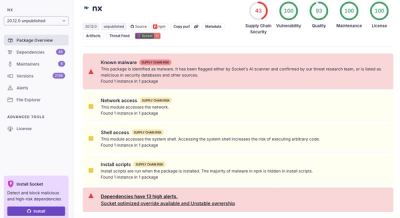
Security News
Risky Biz Podcast: Making Reachability Analysis Work in Real-World Codebases
This episode explores the hard problem of reachability analysis, from static analysis limits to handling dynamic languages and massive dependency trees.
@qctrl/elements-css
Advanced tools
Elements CSS is a collection of CSS variables that extend TailwindCSS theme with semantic variables for Elements Design System.
Elements CSS is a collection of CSS variables that extend TailwindCSS theme with semantic variables for Elements Design System.
pnpm add -D @qctrl/elements-css@latest tailwindcss@latest @tailwindcss/postcss@latest
For most projects, we recommend setting up TailwindCSS and Elements with PostCSS.
https://tailwindcss.com/docs/installation/using-postcss
@import "tailwindcss";
@import "@qctrl/elements-css";
Note: You can also import individual CSS files if you need to omit/override some properties.
@import "tailwindcss";
@import "@qctrl/elements-css/theme/color.css";
@import "@qctrl/elements-css/theme/font.css";
@import "@qctrl/elements-css/theme/typography.css";
/** ... */
For development purposes, you can import both semantic and primitive variables in JSON format:
import semanticVariables from "@qctrl/elements-css/figma/semantic-variables.json";
import primitiveVariables from "@qctrl/elements-css/figma/primitive-variables.json";
FAQs
Elements CSS is a collection of CSS variables that extend TailwindCSS theme with semantic variables for Elements Design System.
The npm package @qctrl/elements-css receives a total of 203 weekly downloads. As such, @qctrl/elements-css popularity was classified as not popular.
We found that @qctrl/elements-css demonstrated a healthy version release cadence and project activity because the last version was released less than a year ago. It has 26 open source maintainers collaborating on the project.
Did you know?

Socket for GitHub automatically highlights issues in each pull request and monitors the health of all your open source dependencies. Discover the contents of your packages and block harmful activity before you install or update your dependencies.

Security News
This episode explores the hard problem of reachability analysis, from static analysis limits to handling dynamic languages and massive dependency trees.

Security News
/Research
Malicious Nx npm versions stole secrets and wallet info using AI CLI tools; Socket’s AI scanner detected the supply chain attack and flagged the malware.

Security News
CISA’s 2025 draft SBOM guidance adds new fields like hashes, licenses, and tool metadata to make software inventories more actionable.